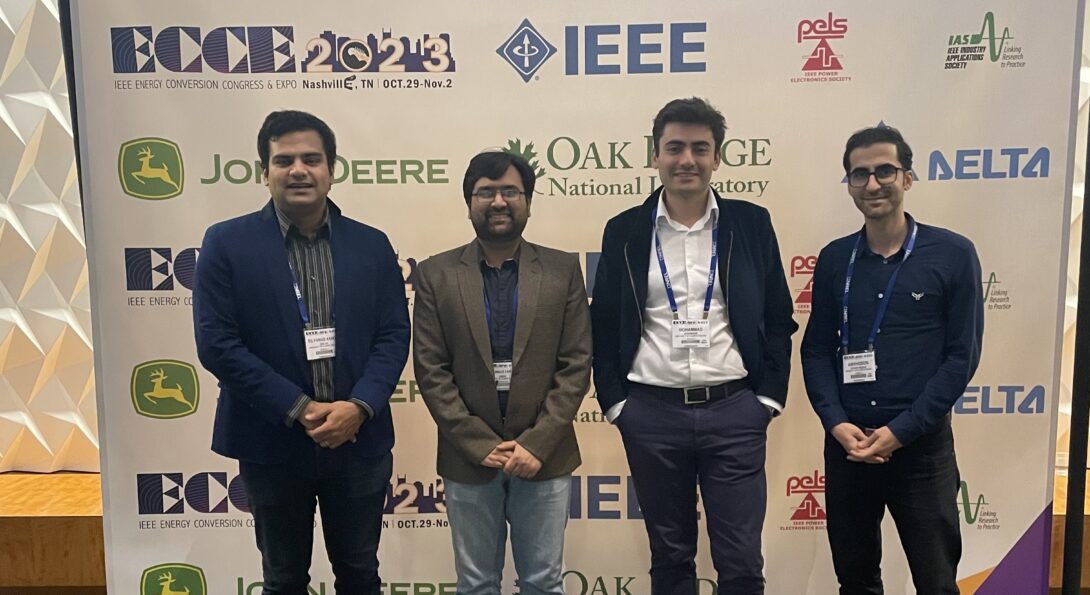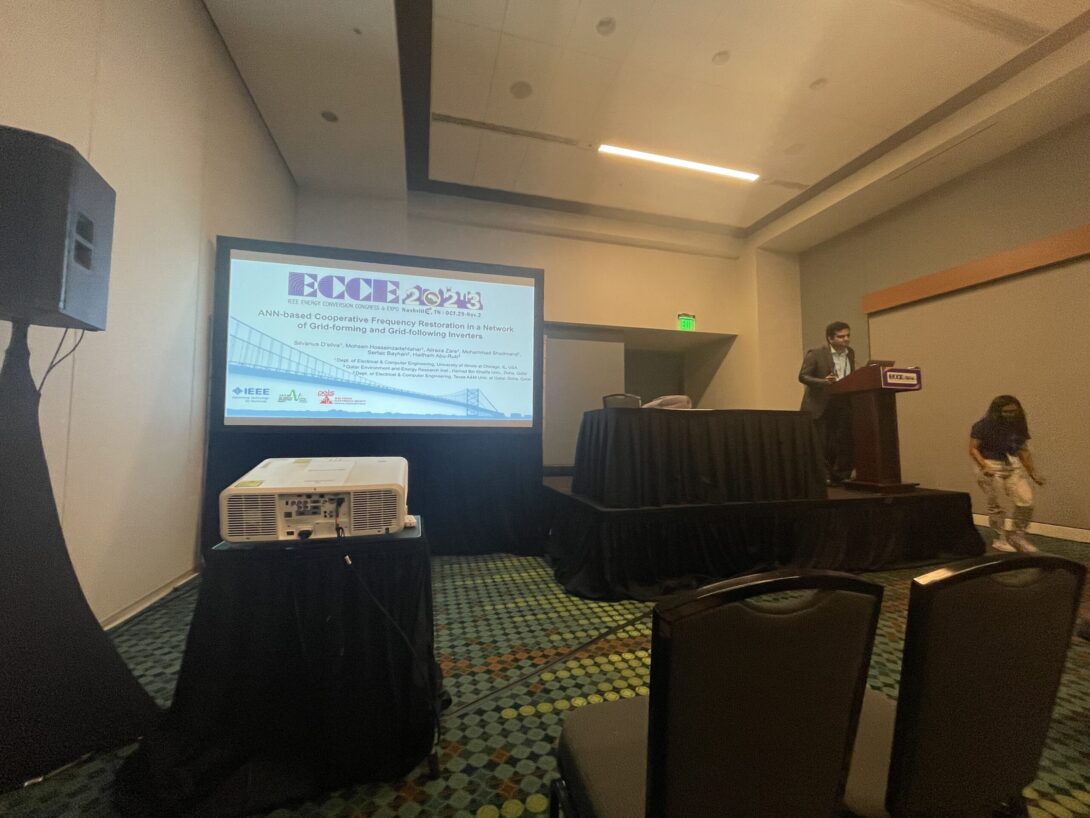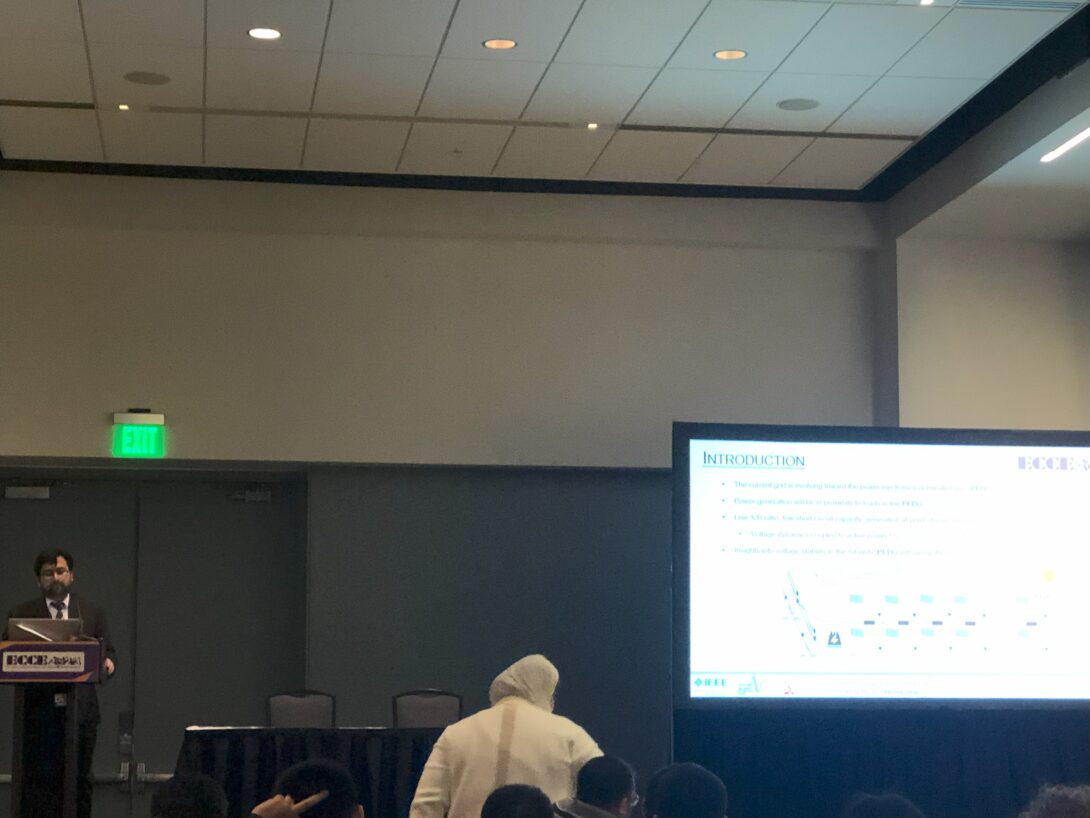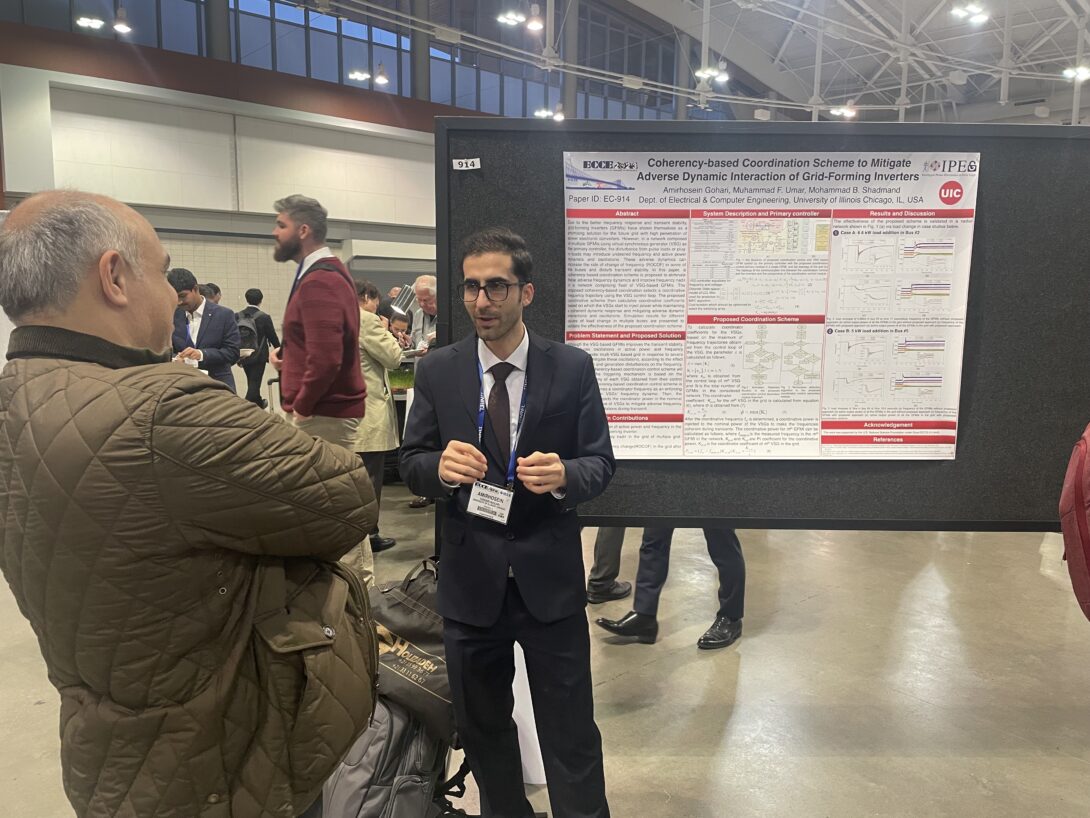7 papers of IPEG researchers presented at the IEEE ECCE 2023 Conference in Nashville, TN!

Introduction
Dr. Shadmand and 3 IPEG researchers Silvanus D’silva, Muhammad Farooq Umar, and Amirhosein Gohari Nazari attended the Energy Conversion Congress and Expo (ECCE 2023) in Nashville, TN and presented 7 papers.
The 7 papers presented at ECCE 2023 discuss the most recent research outcomes of IPEG lab. These papers focused on applications of artificial intelligence in inverter control, optimal inertia estimation of grid forming inverters, mitigation of adverse dynamic interactions of grid forming inverters, coherency enforcement in cluster of heterogeneous grid forming-grid following inverters, mathematical derivation for voltage stability boundary and an event triggered control for compromised power electronics dominated grid!
Paper 1: ANN-based Cooperative Frequency Restoration in a Network of Grid-forming and Grid-following Inverters

Abstract – An artificial neural network (ANN) inspired cooperative hierarchical control scheme for frequency restoration during sudden source/load variations in a network of grid-forming and grid-following inverter-based resources (IBRs) is proposed. The photovoltaic (PV) sources’ regulated power harvesting ability is leveraged for immediate frequency support in response to potential disturbances. The ANN-inspired supervisory controller (SC) estimates the demanded power (ΔP) to regulate the frequency which is then optimally distributed amongst all PV interfaced IBRs by a Power Allocator (PA) module; located in the secondary layer cluster coordinator (CC). The PA module ensures that the interfaced PV’s generation limits are not violated while also minimizing system losses. Detailed description of each module in the cluster along with their technical specifications are provided. Finally, simulation results that justify the feasibility and robustness of the proposed control scheme to restore the grid frequency in a timely manner are discussed.
List of authors: Silvanus D’silva, Mohsen Hosseinzadehtaher, Alireza Zare, Mohammad B. Shadmand, Sertac Bayhan, Haitham Abu-Rub
Presenter: Silvanus Dsilva
Paper 2: Coherency Enforcement in the Cluster of Heterogeneous Grid-forming and Grid-following Inverters

Abstract – This paper presents a control scheme for enforcing coherency in a power electronics dominated grid (PEDG) comprising multiple grid-forming (GFM) and grid-following inverters (GFL) based distributed generation (DG). Based on different applications and grid requirements, the primary control for DG can vary such as GFM, GFL, etc. Moreover, each DG can have unique parameters such as controller gains, power ratings, and filter model parameters. All these factors intrinsically contribute towards the heterogeneity in the PEDG. Furthermore, DGs are increasing steeply to integrate renewable energy generation. Therefore, performing different analysis on such a large network is becoming a big challenge recently. One of the solutions is performing aggregation based on similar behaving DGs that can significantly decrease the computational burden and analysis time. Thus, this paper proposes coherency enforced (CE) control to acquire coherent and homogeneous dynamic characteristics for inherently heterogeneous cluster of GFM and GFL inverters based DGs. Various case studies are presented to validate the effectiveness of the proposed approach.
List of authors: Muhammad F. Umar, Amirhosein Gohari Nazari, Mohammad B. Shadmand
Presenter: Muhammad F. Umar
Paper 3: Coherency-based Coordination Scheme to Mitigate Adverse Dynamic Interaction of Grid-Forming Inverters

Abstract – Due to the better frequency response and transient stability, grid-forming inverters (GFMIs) have shown themselves as a promising solution for the future grid with high penetration of power electronic converters. However, in a network composed of multiple GFMIs using virtual synchronous generator (VSG) as the primary controller, the disturbance from pulse loads or plug-in loads may introduce undesired frequency and active power dynamics and oscillations. These adverse dynamics can increase the rate of change of frequency (ROCOF) in some of the buses and disturb transient stability. In this paper, a coherency-based coordination scheme is proposed to eliminate these adverse frequency dynamics and improve frequency nadir in a network comprising fleet of VSG-based GFMIs. The proposed coherency-based coordination selects a coordinative frequency trajectory using the VSG control loop. The proposed coordinative scheme then calculates coordinative coefficients based on which the VSGs start to inject power while maintaining a coherent dynamic response and mitigating adverse dynamic interactions and oscillations. Simulation results for different values of load change in multiple buses are presented to validate the effectiveness of the proposed coordination scheme.
List of authors: Amirhosein Gohari, Muhammad Farooq Umar, Mohammad B. Shadmand
Presenter: Amirhosein Gohari
Paper 4: Optimal Inertia Emulation via Adaptive Grid-forming Inverter Selection in Active Distribution Networks
Abstract – This paper presents an optimization algorithm that estimates the equivalent inertia and damping factor required to support the power electronics dominated grids (PEDG) in response to severe load and generation disturbances. The proposed algorithm emulates optimal inertia by adaptively selecting grid-forming inverters (GFMIs) at various locations given their battery energy storage system (BESS) capacities as well as their state-of-charge (SOC) in an active distribution network. The proposed algorithm is implemented in the tertiary layer controller or supervisory controller (SC) of the considered control architecture. Various constraints including maximum frequency deviation which represents the frequency Nadir, rate of change of frequency (ROCOF), and SOC of the batteries are considered for real-time optimization to ensure optimality of emulated inertia and damping factor via GFMIs. Various case studies have been implemented MATLAB/Simulink environment to demonstrate the practicality of the proposed approach.
List of authors: Alireza Zare, Silvanus D’silva, Mohammad B. Shadmand, Sudip K. Mazumder
Presenter: Silvanus D’silva
Paper 5: Event-Triggered Consensus Distributed Control Scheme for a Compromised Power Electronics-Dominated Grid
Abstract – This article presents an event-triggered consensus dynamics control scheme for multiple grid-following inverters (GFLIs) in a power electronics-dominated grid (PEDG). The main objective is to address the voltage and frequency stability for a network of GFLIs in post stealthy cyberattack scenarios. Particularly, the considered stealthy cyberattack scenario is when the centralized secondary control layer dispatched set-points are compromised. The objective of the proposed event-triggered consensus dynamics control is to regain normal main point of common coupling (PCC) bus voltage and frequency levels in the PEDG. This is accomplished through distributing the reactive and active power among the GFLIs to correct the frequency and the voltage of the network. This consensus dynamics control is validated with five different switch-level simulation scenarios in MATLAB/Simulink. These switch-level simulations demonstrate that the GFLIs are capable to operate independent of the compromised secondary control layer in 100% inverter-based grid with different dynamical coupling and topology.
List of authors: Ahmad Khan, Mohsen Hosseinzadehtaher, Mohammad B. Shadmand.
Presenter: Amirhosein Gohari
Paper 6: On The Voltage Stability of The Power Electronics-Dominated Grid: Mathematical Derivation of The Stability Margin
Abstract – This article provides insights into voltage stability problem in the futuristic power electronics-dominated grid (PEDG) through detailed mathematical derivations. It is revealed in this article, that active power control will be crucial for attaining voltage stability in the futuristic PEDG. This is due to its anticipated resistive nature as being a network situated at the grid-edge. This resistive nature creates strong coupling between voltage and active power. It is worth mentioning that the authors expect in the future, reactive power control may not be sufficient for resolving voltage stability problem in the futuristic PEDG. It is expected that the voltage will be decoupled from the reactive power. Besides, this article revisits the mathematical derivation of how the voltage stability margin at bus i is impacted by its own reference change. Then, it extends this derivation to how an adjacent bus j reference change impacts the voltage stability margin at bus i. Finally, the theoretical analysis is verified by running multiple scenarios.
List of authors: Ahmad Khan, Mohammad B. Shadmand, Sudip Mazumder
Presenter: Muhammad F. Umar
Paper 7: An AI-Based Real-time Intrusion Detection System for Power Electronics-Dominated Grid: Attack on Inverters PQ Set-Points
Abstract – This work presents a long short-term memory (LSTM) neural network based method for real-time detection of intruded power setpoints of grid-following inverters (GFLIs) in power electronics dominated grids (PEDG). The supervisory control layer in PEDG plays a crucial role in coordination and optimal dispatch of GFLIs. Thus, a compromised supervisory control layer and/or the communication line between the supervisory control and primary control layers can jeopardize the stable operation of the network. The attack vector considered in this paper manipulates active (P) and reactive (Q) powers setpoints. The proposed real-time intrusion detection system (IDS) is based on the effect of this attack vector on voltage, current, frequency and rate of change of frequency (ROCOF) sensed at inverters point of common coupling (PCC). Classifying the time series data into normal or anomalous types can help detect attacks on PQ setpoints in real-time. Various source and load disturbances along with anomaly/attack scenarios are considered for database creation and training the neural network. The proposed real-time IDS is then validated in the DER-based PEDG system. The neural network performance characteristics in terms of accuracy and loss proved it to be capable of effectively distinguishing anomalous behavior from regular fluctuations occurring in the PEDG.
List of authors: Asef Zadehgol-Mohammadi, Matthew Baker, Mohammad B. Shadmand.
Presenter: Muhammad F. Umar